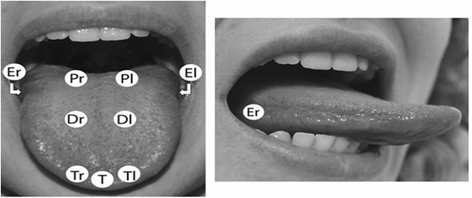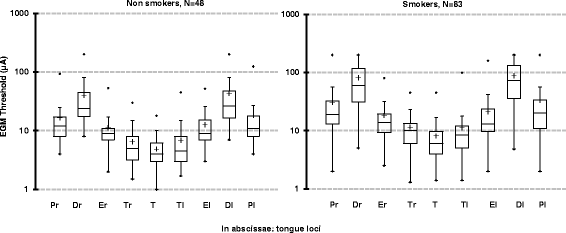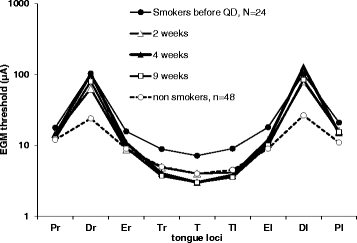Effect of cigarette smoke on gustatory sensitivity, evaluation of the deficit and of the recovery time-course after smoking cessation
- PMID: 28261024
- PMCID: PMC5329949
- DOI: 10.1186/s12971-017-0120-4
Effect of cigarette smoke on gustatory sensitivity, evaluation of the deficit and of the recovery time-course after smoking cessation
Abstract
Background: Study results have shown that chronic exposure to cigarette smoke affects the taste function in humans. However, neither the quantitative impact on taste sensitivity nor the time-course of taste recovery on stopping smoking have been precisely examined.
Methods: The experimental design included 2 phases, (i) a case-control phase comparing the taste sensitivity level measured by Electrogustometric (EGM) thresholds from various parts of the tongue (locus) between smokers (n = 83) and non-smokers (n = 48), (ii) a follow-up study looking at the taste sensitivity recovery in smokers after smoking cessation (n = 24) and compared with non-smokers.
Results: Smokers exhibited significantly lower taste sensitivity than non-smokers - the higher the nicotine dependence (Fagerström scores), the lower the taste sensitivity. After smoking cessation, EGM thresholds decreased progressively, and reached the taste sensitivity range of non-smokers depending on locus and time. After 2 weeks a recovery could be observed on the 3 Tip and the 2 edge loci; the recovery in the posterior loci was complete after 9 weeks, and in the dorsal loci recovery was observed only after 2 months or more.
Conclusions: Smoking cessation does lead to a rapid recovery of taste sensitivity among smokers, with recovery time found to differ based on the sensitivity of loci of the tongue. The use of EGM could potentially be explored as a motivational tool for smoking cessation.
Keywords: Electrogustometry; Taste disturbance; Taste recovery; Tobacco smoking.
Figures




References
-
- Centers for Disease C, Prevention, National Center for Chronic Disease P, Health P, Office on S, Health . How tobacco smoke causes disease: the biology and behavioral basis for smoking-attributable disease: a report of the surgeon general. Atlanta: Centers for Disease Control and Prevention (US); 2010. Publications and reports of the surgeon general. - PubMed
-
- Le Den R, Le Mouel C, Daurel P, Renon P, Fleys J. Results of systematic gustometry in 350 subjects. Ann Otolaryngol Chir Cericofac. 1972;89:659–669. - PubMed
LinkOut - more resources
Full Text Sources
Other Literature Sources

